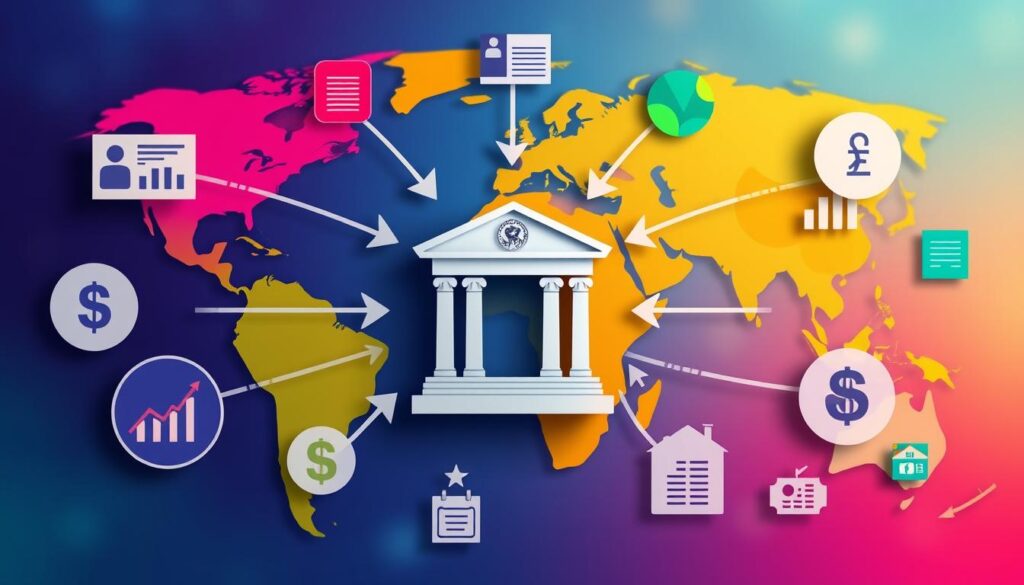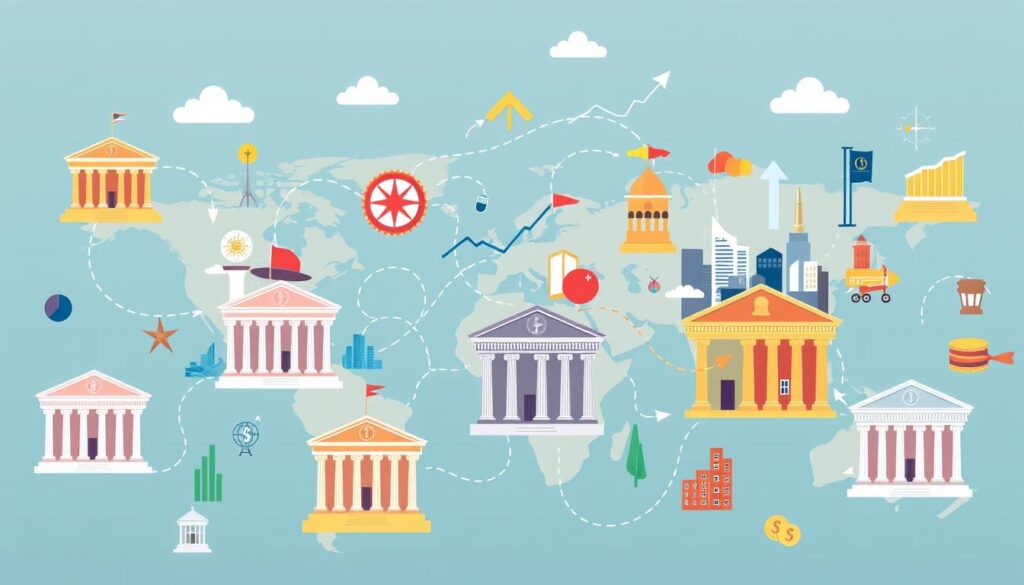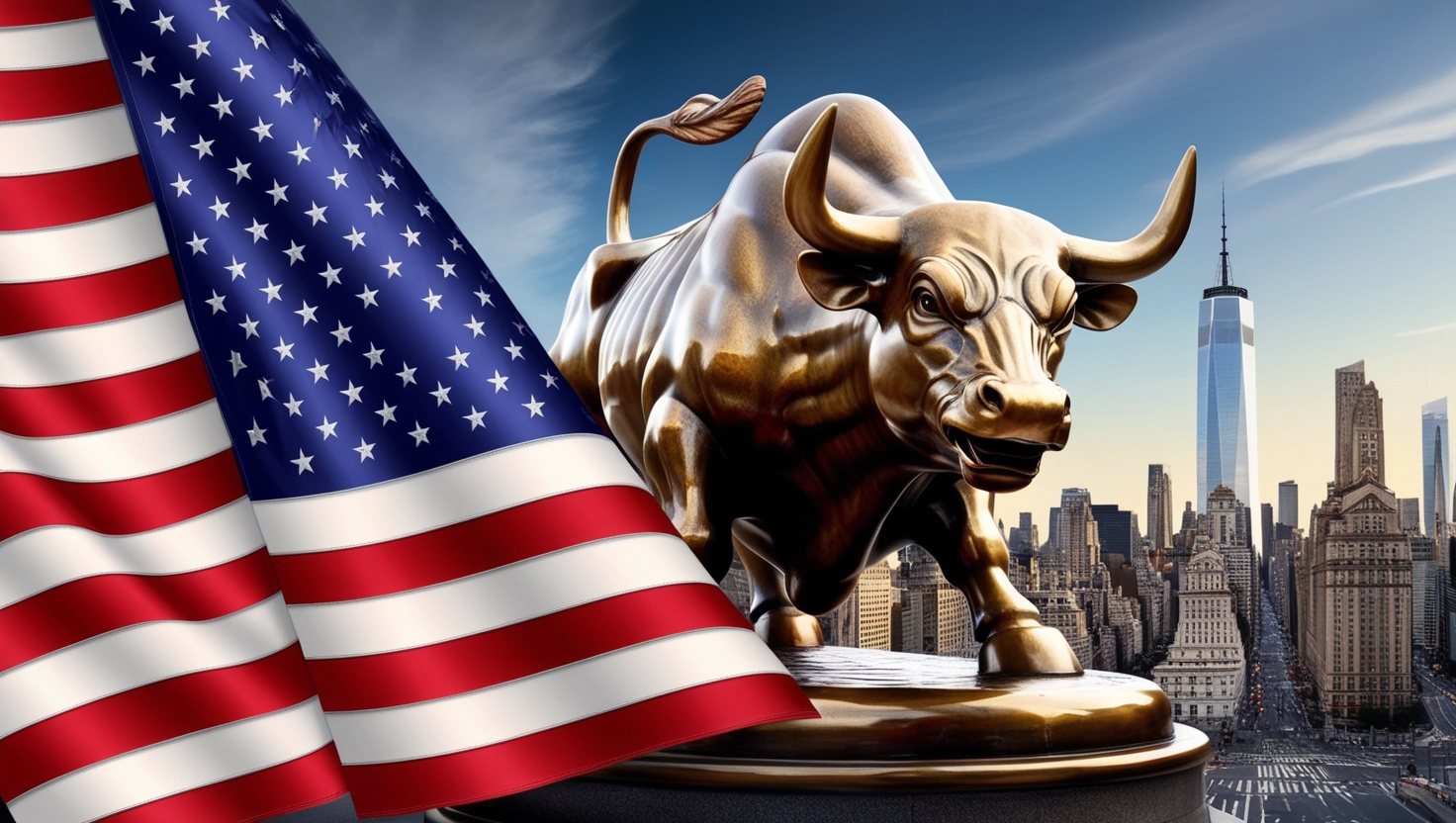Fed Rate Cuts: Global Market Impact Explained
The Federal Reserve’s (Fed) decisions on interest rates are key for both local and global finance. It’s important for investors, policymakers, and economists to grasp the Fed’s rate cuts’ global impact. These cuts have big effects on economies worldwide, changing how people invest, currency values, and economic growth.
This shows how monetary policy affects the economy. It’s crucial to understand how these actions spread across the globe. We’ll explore the details of these rate changes and their wide-reaching effects on global economies.

Key Takeaways
- Fed rate cuts significantly influence global economic dynamics.
- Understanding políticas monetárias dos bancos centrais is crucial for assessing market reactions.
- Interest rate changes affect international trade and investment flows.
- Monitoring impactos econômicos globais can provide insights into future market conditions.
- Investor strategy should align with Fed decisions to optimize returns.
The Basics of Fed Rate Cuts
Fed rate cuts are key to the economy’s health. Central banks, like the Federal Reserve, use these cuts to control money flow. They adjust the short-term federal funds rate to lower borrowing costs for people and businesses.
Lower interest rates help the economy grow. They make spending and investing easier. This is especially true when the economy is slow or in a downturn.
When rates go down, money flows better in the market. People borrow more for homes, cars, or school. Businesses invest more, creating jobs and boosting the economy.
Knowing about Fed rate cuts is crucial. It helps us understand how money moves in the economy. This knowledge is essential for seeing how the economy might grow or change.
How Interest Rate Cuts Influence Economic Growth
Interest rate cuts are key to boosting economic growth. When rates go down, borrowing costs drop too. This makes it easier for businesses to invest and grow.
For consumers, lower rates mean cheaper loans for big purchases. This encourages spending, boosting demand for goods and services.
Many economic indicators show positive changes with rate cuts. For example, GDP often goes up as spending and business activities increase. Employment rates may also rise as companies hire more to meet demand.
Looking back, rate cuts have helped the economy recover. The Federal Reserve’s moves during the 2008 crisis are a prime example. By setting rates near zero, they helped stabilize markets and support recovery.
| Indicators | Before Rate Cut | After Rate Cut |
|---|---|---|
| GDP Growth Rate | 1.5% | 3.0% |
| Unemployment Rate | 8.0% | 5.5% |
| Consumer Spending Growth | 2.0% | 4.5% |
| Business Investment Growth | 3.0% | 6.0% |
The link between interest rates, spending, and investments is crucial. Central banks use rate cuts to create a strong economic environment. This helps increase prosperity for everyone.
The Mechanism Behind Fed Rate Cuts
The Federal Open Market Committee (FOMC) is key in changing interest rates. They look at inflation and job rates to make decisions. These moves help the economy when it’s tough.
It’s important to know how these rate changes affect the economy. When the federal funds rate goes down, it makes borrowing cheaper for people and businesses. This can lead to more spending and investment. As spending goes up, so does the demand for goods and services, boosting production.
This process helps stabilize the economy. By making credit easier to get, the FOMC fights off economic downturns. This helps the economy slowly get back on track. Table 1 below shows the main parts of this process.
| Stage | Description |
|---|---|
| Interest Rate Change | FOMC decides to lower rates to stimulate growth. |
| Lending Rates | Commercial banks decrease lending rates following the fed rate cut. |
| Consumer Behavior | Lower rates encourage consumers to borrow and spend. |
| Business Investment | Companies invest in projects due to cheaper borrowing costs. |
| Economic Activity | Increase in production and consumption leads to economic growth. |
Understand the importance of the Fed’s interest rate cuts for global markets
The decisions made by the Federal Reserve on interest rates are crucial for global investments. Rate cuts by the Fed have big effects on international trade and foreign investments. As the world economy gets more connected, it’s key for businesses and investors to understand these impacts.
Implications for International Trade
When the Fed lowers interest rates, it can change the U.S. dollar’s value. A weaker dollar makes American exports cheaper but imports pricier. This change in currency value affects global markets, changing trade balances and making countries rethink their trade plans.
Businesses respond by adjusting prices and looking for new markets. This shows how Fed rate cuts impact global trade.
Effects on Foreign Investments
Lower U.S. interest rates attract foreign investors. They look for better returns in other countries. This makes countries with strong economies and good investment climates more appealing, drawing in more capital.
This has a big impact on the world economy, leading to stronger ties between nations. It also helps investors spread their investments globally.

Impact of Interest Rate Cuts on Financial Markets
Interest rate cuts can cause big changes in financial markets. They affect both stocks and bonds. Knowing how these changes work helps investors understand the market better.
The relationship between borrowing costs and asset prices is key. It brings both chances and challenges for those in the market.
Stock Market Reactions
Stock markets usually go up when interest rates fall. Lower borrowing costs make companies want to grow. This means they expect to make more money.
As investors hear this, they often buy more stocks. This makes stock prices go up. It can lead to a long period of good times for the market.
Bond Market Adjustments
The bond market changes a lot when interest rates go down. Bonds with higher yields become more appealing. This causes prices to change.
These changes affect the whole bond market. Investors try to find the best deals for their fixed-income investments.
| Market Type | Reaction to Rate Cuts | Key Implications |
|---|---|---|
| Stock Market | Positive reaction, typically rises | Increased corporate investment and growth |
| Bond Market | Fluctuations in bond pricing | Higher demand for existing bonds with better yields |
The way interest rate changes affect stocks and bonds shows their big impact. By studying these changes, investors can make smart moves in the market.
Global Market Reactions to Fed Policy Changes
Fed policy changes affect markets worldwide, not just in the U.S. Emerging markets show unique reactions to these changes. When U.S. monetary policy shifts, these countries adjust their financial plans. This helps them manage risks and find new opportunities.
Trends in Emerging Markets
Emerging markets quickly respond to Fed policy changes. When the Fed changes interest rates, money flows in or out of these markets. This affects different sectors.
- Increased capital flight from riskier assets as investors seek stability.
- Heightened inflationary pressures, particularly in countries relying heavily on imports.
- Growth in local investment opportunities as currencies adjust and give competitive advantages.
Impact on Currency Fluctuations
Changes in Fed rates lead to currency value shifts. These changes affect trade and investment. Key points include:
- Strengthening of the U.S. dollar, often leading to depreciation of emerging market currencies.
- Increased volatility in global forex markets, impacting export competitiveness.
- Opportunities for investors looking for arbitrage in changing currency valuations.
The Role of Fed Rate Cuts in Investment Strategies
Fed rate cuts are key in estratégias de investimento. Investors watch the interest rate closely. They adjust their plans based on the economy’s state. Rate cuts change how much money you can make and how much risk you take.
Investors do a análise de risco to check their investments. They look at which ones do well when rates are low and which might not. This helps them pick the right mix of investments to make money and avoid losses.
Rate cuts affect different investments in different ways. This means investors need to be quick to change their portfolios. They often move money to stocks, real estate, and other assets that grow in low-rate times. Knowing how to adjust is crucial for smart investing.
| Asset Class | Pre-Cuts Performance | Post-Cuts Performance | Risk Level |
|---|---|---|---|
| Stocks | Moderate Gains | High Gains | Medium |
| Bonds | Low Returns | Stable Returns | Low |
| Real Estate | Stable | Increased Value | Medium |
| Commodities | Declining Prices | Volatile | High |
Using cortes de juros do fed in investment plans helps investors stay ahead. By knowing how assets act during rate cuts, they can handle market changes better. This can lead to more success in a changing financial world.
Long-Term Consequences of Fed Rate Adjustments
The Fed’s interest rate changes have caught the eye of many. They see how long low rates can lead to a *booming* economy but also to big asset bubbles. People feel good when markets rise, but things change when the bubble pops.
Also, low interest rates make saving less appealing. This changes how people act financially. Instead of saving, they look for riskier investments, making markets more unstable.
These changes affect the economy over time. Economic cycles can get longer or change because of central bank actions. Low rates make people expect more from investments, leading to ups and downs in the market.
In short, knowing the long-term effects of Fed rate changes is key. The market’s behavior changes with the economy. Each rate change has big effects on money and investments. Those who get these changes right can find chances and risks in the economy’s shifts.
Global Economic Indicators and Fed Rate Cuts
It’s important to know how cortes nas taxas de juros affect the economy. Metrics like GDP growth and job rates help us see how money policy changes the economy.
Analyzing GDP Growth
Lower interest rates can boost borrowing and spending, leading to economic growth. When countries cut rates, people tend to spend more, which helps their GDP grow. Here’s what happens in different countries:
| Country | GDP Growth Rate Pre-Cut | GDP Growth Rate Post-Cut |
|---|---|---|
| United States | 2.5% | 3.7% |
| Germany | 1.8% | 2.6% |
| Brazil | 1.2% | 2.9% |
Unemployment Trends
Cortes nas taxas de juros also impact tendências de desemprego. Lower borrowing costs can lead to more jobs. When rates drop, unemployment often falls. Here’s how it plays out in different places:
| Country | Unemployment Rate Pre-Cut | Unemployment Rate Post-Cut |
|---|---|---|
| United States | 4.0% | 3.5% |
| Germany | 5.1% | 4.6% |
| Brazil | 12.0% | 9.5% |
Comparative Analysis: Other Central Banks’ Responses
To understand the comparação entre bancos centrais, we must look at their strategies. The Federal Reserve, European Central Bank (ECB), and Bank of Japan (BoJ) have different ways of handling interest rates. Their choices depend on their economic situations and goals.
The ECB uses negative interest rates when the economy is slow. The BoJ has used quantitative easing for a long time. The Fed, on the other hand, changes rates based on inflation and jobs. These differences show how each bank faces its own economic challenges.
| Central Bank | Key Response | Effectiveness |
|---|---|---|
| Federal Reserve | Interest rate cuts based on inflation and employment | Moderate success in stimulating growth |
| European Central Bank | Negative interest rates to encourage lending | Mixed results, with ongoing inflation concerns |
| Bank of Japan | Quantitative easing for extended periods | Prolonged deflationary environment |
This table shows important policies and their results. It highlights the complexity of the global monetary scene. Each respostas de políticas monetárias reflects the economic, cultural, and structural aspects of their economies.

Future Predictions and Trends Following Fed Rate Cuts
The previsões de mercado after Fed rate cuts show a mix of possible outcomes. Lower rates mean cheaper borrowing for companies and people, boosting the economy. This could lead to more spending by consumers, helping the economy grow in the short term.
Looking ahead, different areas could see changes. For example, the housing market might get a boost as mortgage rates fall. This could encourage more people to buy homes. Also, startups and small businesses might find it easier to get funding, leading to new jobs and ideas.
But, the long-term impacto econômico is also important. Low interest rates for too long could cause asset bubbles, especially in real estate and stocks. Investors might look for better returns in these areas. Also, banks might struggle to stay profitable if their interest margins get too thin.
To grasp these changes, here’s a table showing expected trends from Fed actions:
| Trend | Description | Potential Impact |
|---|---|---|
| Increased Consumer Spending | Lower interest rates make borrowing cheaper. | Boost in retail and service sectors. |
| Housing Market Growth | More affordable mortgages stimulate buying activity. | Increase in home sales and construction jobs. |
| Investment in Innovation | Looser capital conditions facilitate startup growth. | Job creation and enhanced competition. |
| Potential Asset Bubbles | Investors converge on riskier assets for higher returns. | Market destabilization in the event of corrections. |
Conclusion
We talked about how the Federal Reserve’s interest rate cuts affect the world’s economy. The role of the Fed is huge, as its actions influence many areas. This includes how much people spend and trade between countries.
It’s clear that the world’s economies and markets are closely linked. This means everyone needs to keep up with news. Knowing what’s happening is crucial, especially with the Fed’s decisions.
Remember, staying alert to Fed policies is key. These updates help us understand the ever-changing global markets. Being ready for changes is important, thanks to the Fed’s actions.
FAQ
What are the primary effects of Fed rate cuts on the global economy?
Fed rate cuts make borrowing cheaper. This encourages people to spend more and businesses to invest. It helps the U.S. economy grow and also boosts the global economy.
How do Fed interest rate cuts impact currency exchange rates?
Fed rate cuts can make the U.S. dollar weaker. This happens because other currencies might offer better returns. Changes in currency values can affect trade and investments worldwide.
What role does the Federal Open Market Committee (FOMC) play in rate cuts?
The FOMC sets the federal funds rate based on the economy. They aim to control inflation and boost growth. Their decisions affect both the U.S. and global markets.
How do adjustments in Fed rates affect the stock market?
Rate cuts usually make the stock market happy. Lower interest costs can increase corporate profits. This leads to more buying, especially in growth sectors.
What long-term consequences can arise from prolonged low interest rates?
Long periods of low rates can cause asset bubbles and lower savings. It also leads to risky investments. These factors can destabilize the financial system and change how people save.
How should investors adjust their strategies following Fed rate cuts?
Investors should look at risk and adjust their portfolios. They might diversify into sectors that do well with lower rates. It’s also important to watch for market volatility.
What metrics should investors monitor to gauge the impact of Fed rate cuts?
Investors should watch GDP growth and unemployment rates. These indicators show how rate changes affect the economy and investments.
How do emerging markets react to changes in Fed policies?
Emerging markets adjust their rates to keep capital in or stabilize their currency. This can greatly impact their economic stability and growth.
Can you explain the relationship between Fed cuts and international trade?
Fed rate cuts can change currency values. A weaker dollar makes U.S. goods cheaper abroad. This can boost exports but also raise import costs.


